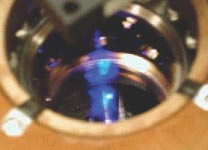A high-powered JILA collaboration led by JILA Fellows Jun Ye and Chris Greene is making important progress toward developing an ultrastable, high-accuracy optical atomic clock. The new optical clock design will use a variety of laser sources including a femtosecond comb and a diode laser stabilized with an optical cavity, which, in turn, is locked to a narrow energy level transition in ultracold strontium atoms.
In the April 18 (2005) Physical Review Letters, a team from Ye's lab reported the precise and accurate measurement of a naturally occurring clock transition in ultracold strontium. The team included postdocs Tetsuya Ido and Tom Loftus and graduate students Martin Boyd, Andrew Ludlow, and Kevin Holman. The researchers also determined that the clock transition they'd measured was likely not ideal for a next-generation atomic clock.
Ye's next step was to initiate a collaboration with theorist Chris Greene, Greene's postdoc Robin Santra, visitor Ennio Arimondo, Ido, and himself. This group's goal was to dream up a better scheme for an optical atomic clock that used a higher quality factor and a more stable transition in ultracold strontium atoms. They succeeded with a design that uses two lasers (and three atomic levels) to create a unique energy level transition that otherwise would not occur in nature. The new transition, which owes its existence to quantum interference, is very narrow and very stable.
To create a prototype for a new high-accuracy optical clock, a team composed of Ido, Boyd, Ludlow, Tanya Zelevinsky, Seth Foreman, Sebastian Blatt, Mark Notcutt, and Ye has built a highly stabilized probing laser. The researchers also trapped the ultracold strontium atoms in an optical lattice that provides long interaction times for probing the atomic transition. Boyd and Ludlow believe the new clock may eventually prove to be more than 10 times more stable and accurate than NIST's primary cesium atomic clock. A paper reporting the new optical atomic clock scheme appeared in the May 6 (2005) Physical Review Letters. - Julie Phillips




